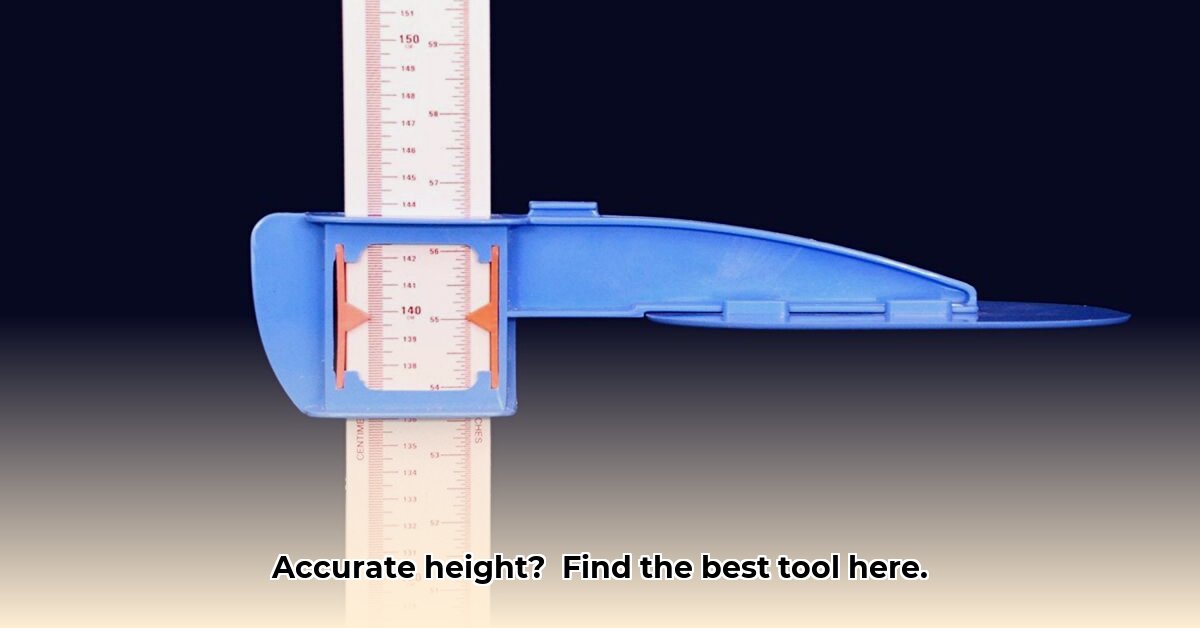Accurate height measurement is vital in healthcare, impacting diagnoses, treatments, and patient monitoring. From tracking a child’s growth to assessing nutritional status and diagnosing conditions, precision is key. Selecting the right height measurement tool is paramount, requiring an understanding of different device types and their suitability for specific situations and patients. This guide explores mechanical, digital, and ultrasonic stadiometers, covering their mechanisms, accuracy, limitations, and effective use. We’ll address cost, ease of use, regulatory compliance, and system integration, along with best practices and future technology trends. Let’s ensure you obtain the most accurate height measurements for your patients, aiding clinicians in providing the best possible patient care.
Height Measurement Tools in Healthcare: A Comprehensive Guide
Choosing the right height measurement tool is crucial for optimal patient care. Let’s examine the available options to determine the best fit for your needs, considering factors like cost-effectiveness and long-term reliability. How can healthcare professionals make informed decisions about height measurement tools in diverse clinical settings, considering the nuances of each device?
Exploring Height Measurement Options
We’ll delve into mechanical, digital, and ultrasonic height measuring devices, each with unique advantages and disadvantages for accurate body measurement. Understanding these differences can help healthcare providers select the most appropriate tool for their specific needs and budget.
- Mechanical Stadiometers: The Reliable Standard: These robust tools offer durability and affordability, measuring height directly using a sliding head along a fixed rod. Their simplicity makes them easy to use and maintain. However, readings rely on visual interpretation, introducing potential for human error, and data sharing is limited. They are ideal for smaller clinics with budget constraints where simplicity and longevity are prioritized. What specific strategies can be employed to minimize human error when using mechanical stadiometers?
- Digital Stadiometers: Enhancing Accuracy and Efficiency: Digital stadiometers offer quicker, more accurate digital readouts, reducing the potential for human error inherent in manual readings. Many models offer data storage and connectivity, improving portability and workflow. While requiring more maintenance than mechanical models and often being more expensive upfront, they represent a significant upgrade in terms of efficiency and data management. Do the benefits of increased efficiency and reduced error justify the higher initial cost and maintenance requirements of digital stadiometers?
- Ultrasonic Stadiometers: The Innovation in Measurement: These advanced devices employ sound waves for highly accurate and rapid height measurements, offering excellent portability and non-contact measurement. This reduces the need for physical contact, enhancing patient comfort and hygiene. However, they are more expensive and may require specific environmental conditions for optimal performance, and can be sensitive to movement. How do environmental factors affect the accuracy of ultrasonic stadiometers, and what measures can be taken to mitigate these effects?
Feature Comparison: A Detailed Overview
The table below provides a detailed summary of key features across the three types of stadiometers. Remember, the “best” choice depends entirely on your specific needs and clinical context. What key performance indicators (KPIs) should healthcare providers use to evaluate the effectiveness of a stadiometer in their specific practice?
| Feature | Mechanical Stadiometer | Digital Stadiometer | Ultrasonic Stadiometer |
|---|---|---|---|
| Accuracy | ±0.5-1 cm (dependent on user consistency) | ±0.5 cm | ±0.2-0.5 cm (environment dependent) |
| Cost | \$100 – \$300 | \$300 – \$800 | \$800 – \$1500+ |
| Portability | Moderate; some models are collapsible | Good; often battery-powered | Excellent; lightweight and easy to transport |
| Maintenance | Very low; minimal moving parts | Moderate; requires battery replacement and occasional cleaning | Low to Moderate; sensor cleaning and occasional calibration |
| Data Integration | None; manual recording required | Often connects to EHR systems via USB or Bluetooth | Typically offers wireless connectivity and EHR integration |
| Regulatory Compliance | Generally straightforward; check local requirements | Requires verification of electrical safety and accuracy | Requires verification of sensor accuracy and calibration |
| Durability | High; robust and long-lasting | Moderate; can be sensitive to impacts | Moderate; sensors can be delicate |
| Ideal For | Budget-conscious clinics, field use, basic measurements | Clinics requiring digital records, improved accuracy | High-volume practices, research, non-contact measurement |
Selecting the Right Tool: Key Considerations
Several factors influence stadiometer suitability. Thoroughly assess your clinical setting, patient population, budget, and regulatory compliance requirements before making a selection. How do these factors interact to determine the optimal choice for a specific healthcare environment, and what are the potential trade-offs?
- Your Clinic or Hospital’s Setup: High-traffic emergency rooms benefit from fast, accurate ultrasonic models that minimize patient contact. Smaller pediatric offices or family practices may find simpler digital stadiometers sufficient. Mobile clinics require portable and durable options, such as mechanical or battery-powered digital models.
- Your Patients: Measuring infants and young children requires greater precision and specialized stadiometers designed for pediatric use, often including features like secure head and footrests. Bariatric patients require stadiometers with higher weight capacities and wider platforms.
- Your Budget: While mechanical stadiometers offer the lowest initial cost, digital or ultrasonic models may offer better long-term value due to increased efficiency, reduced errors, and data integration capabilities. Consider the total cost of ownership, including maintenance, calibration, and potential downtime.
- Rules and Regulations: Ensure your chosen stadiometer meets all relevant safety and performance standards, aligning with industry guidelines for patient well-being. Check local and national regulations regarding medical device accuracy and calibration.
Optimizing Height Measurement: Best Practices
Follow these steps for accurate and efficient height measurement, enhancing patient care and diagnostic precision. Standardized measurement protocols are critical for achieving reliable results in clinical settings and minimizing variability.
- Calibration: Regularly check the stadiometer’s accuracy using a calibrated measuring rod or block, following the manufacturer’s instructions. Accurate calibration is crucial for ensuring data integrity and consistent measurements over time.
- Consistent Technique: Implement standardized measurement procedures for all users, including patient positioning, head alignment (Frankfort plane), and reading techniques. Proper patient positioning can significantly enhance accuracy in clinical readings. The Frankfort plane is an imaginary line from the ear canal to the lower edge of the eye socket, which should be horizontal during measurement.
- Data Management: Integrate your stadiometer with your electronic health records (EHR) system, improving workflow and reducing errors, streamlining clinical data entry and analysis. Ensure data privacy and security compliance when transmitting and storing patient data.
- Routine Maintenance: Regularly clean and maintain your stadiometer according to the manufacturer’s guidelines for optimal accuracy and longevity, preventing malfunctions and extending equipment lifespan. Check for loose parts, damaged components, and sensor obstructions.
The Future of Height Measurement
Height measurement technology is continually evolving, driven by advancements in sensor technology, data processing, and connectivity. Remote monitoring and telehealth applications are emerging, allowing for height measurements to be taken in non-clinical settings. What are the potential benefits and challenges of remote height monitoring in terms of data accuracy, patient compliance, and data security?
In summary, choosing the right height measurement tool requires balancing accuracy, cost, convenience, and regulatory compliance. Current tools offer a range of options, with future developments likely to enhance measurement capabilities, enabling improved diagnostic precision and patient care. Consider all factors carefully, and regularly review your equipment and procedures to ensure optimal performance.
Selecting the Best Stadiometer for Pediatric Growth Monitoring: A Detailed Guide
Key Takeaways:
- Accurate height measurement is crucial for pediatric growth monitoring to identify developmental concerns and health issues early on. Consistent and accurate measurements are vital for tracking growth velocity and identifying deviations from expected growth curves.
- Several stadiometer types exist, each with unique pros and cons for measuring height accurately in children. Understanding these differences is crucial for making an informed decision.
- Selecting the right stadiometer depends on the clinical setting, budget, and patient population, ensuring it meets their specific needs. Consider the age range of your patients, the space available, and the level of portability required.
- Proper use, regular calibration, and consistent maintenance are essential for reliable results, supporting accurate growth tracking. Training staff on proper measurement techniques is essential to minimize variability.
Understanding Pediatric Growth Monitoring Needs
Before diving into specific models, clarify your specific needs for pediatric growth monitoring. Are you a pediatrician in a busy clinic, a school nurse performing routine screenings, or a parent tracking a child’s growth at home? Your setting will dictate the features you need in a stadiometer.
- Clinic Setting: Requires a durable, accurate stadiometer with EHR integration for efficient data management.
- School Setting: Needs a portable, easy-to-use stadiometer for quick and accurate screenings of multiple children.
- Home Setting: Benefits from an affordable, user-friendly stadiometer for tracking growth trends over time.
This is the starting point of how to choose the best stadiometer for pediatric growth monitoring. What specific needs must be considered for pediatric growth monitoring in various clinical settings, taking into account different age groups and developmental stages?
Types of Stadiometers for Pediatric Use
The market offers various stadiometers for precise measurements. Let’s explore the main
- Google Work-Life Balance: The Reality Behind the Perks - December 9, 2025
- Achieve Consulting Work-Life Balance: A Practical Guide - December 7, 2025
- Achieve Anesthesiology Work-Life Balance: Your Guide - December 4, 2025














